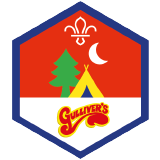
Make tin can pasta
You’ll need
- Firewood
- Fire lighter (for example, matches or ferro rod)
- Tin can (clean and food safe)
- Heatproof oven gloves
- Heatproof tongs
- First aid kit (including for burns)
- Ways to put the fire out
- Cutlery
- Fire bucket
Before you begin
- Use the safety checklist to help you plan and risk assess your activity. There's also more guidance to help you carry out your risk assessment, including examples.
- Make sure all young people and adults involved in the activity know how to take part safely.
- Make sure you’ll have enough adult helpers. You may need some parents and carers to help.
- Check for allergies, intolerances, fasting, food-related medical conditions, eating disorders, food sensitivities or dietary requirements, then adjust the food items used as needed. This may include making sure there’s no cross-contamination of packaging and no cross-contamination during the storage, preparation, cooking and serving.
- You may need to use separate chopping boards, equipment and utensils, such as tongs or toasters, for different dietary requirements, allergies and foods.
- If you’re unsure, check with the young person and their parents or carers. You can check with the adult directly if it’s a volunteer or helper.
- Some people may not like certain food textures or tastes and that’s OK. People don’t need to use all the ingredients if they don’t want to, and no-one should be made to try foods if they don’t want to. You can try to find an alternative for them.
- To make a campfire, everyone should get into groups. An adult should always be assigned to and supervising each group during this activity.
- Remember to give a safety briefing for building a campfire and methods you’re using. You may wish to demonstrate the methods or activity before you start.
- Before starting, make sure their hair is tied back, neckers and loose clothing tucked in, and any coats are zipped up.
- Each group should help to build and light one campfire, or each group could build and light their own campfire in a suitable, safe space. This’ll be depending on how many campfires you’ll want, need and can safely manage.
- Once a campfire or barbecue has been built and is lit, an adult should always supervise it. Our activities, Campfire admirers or Construct a campfire, can help you to do this.
- You’ll use the hot embers to cook on, so the fire will need enough time to die down before cooking. This decreases the chance of carbon monoxide being present and gives the best cooking heat. We have more guidance on different cooking methods.
- You could run our fire safety activities, Fuel air ignition and Sitting safely by a campfire, prior to running this session.
- Make sure that everyone’s fires have been built outdoors in clear, open areas, with plenty of ventilation, and away from any areas where people will be sleeping.
- Remember to have a hand washing station and take extra hygiene precautions when handling food. Look at our guidance on food preparation.
- Make sure you have all the ingredients ready.
- Once everyone has finished using the fire, don’t add any more wood. The fire will slowly begin to die down.
- Ask young people to stay away from the fire while it’s being put out.
- Using a stick, but not one that’s been in the fire, an adult should carefully spread out the wood and embers, so they cool down quickly. An adult should then slowly pour water over the smouldering wood and ashes to make sure they’re fully extinguished. Use the stick to mix the water through the ashes.
Planning and setting up this activity
-
Remember to give a safety briefing for the cooking equipment and methods you’re using. You may wish to demonstrate the methods or activity before you all start cooking.
Ingredients
- A pasta of your choice
- Water
- Salt
- Tomato sauce (optional)
- Toppings, such as cheese (optional)
Prep time: 5 minutes
Cook time: 5 minutes
Makes: one per person
Running the activity
- Gather everyone together and explain you’re going to be cooking pasta in a tin can.
- Everyone should wash their hands, then ask everyone to get into groups. They should gather the equipment and ingredients they need. An adult should always be assigned to and supervising each group during this activity.
- Remember to give a safety briefing for the cooking equipment and methods you’re using. You may wish to demonstrate the methods or activity before you all start cooking.
- Clean the tin can thoroughly, removing any labels or residue, and make sure there are no sharp edges.
- With an adult’s help, punch two small holes near the top rim of the can, so that they’re opposite each other. This'll allow you to insert a piece of wire or string to help you move the tin can.
- Fill the tin can about two-thirds full of water, then add a pinch of salt to the water.
- Put on heatproof gloves, then place the tin can directly onto the hot coals using heatproof tongs, making sure to handle it safely and with adult supervision. It should be stood upright.
- Once the water comes to a boil, carefully add the pasta. Make sure to not add too much pasta, as the can shouldn’t overflow.
- Stir the pasta occasionally to prevent it from sticking and to make sure it cooks evenly. Cook the pasta according to the package instructions or until it reaches your desired level of tenderness. This usually takes around 8-12 minutes, depending on the type of pasta.
- Once the pasta is cooked, an adult should help you carefully remove the tin can from the fire using heatproof tongs and wearing heatproof gloves. Remember, the cans will be extremely hot, so make sure to have a flat, stable and heatproof surface to place them, out of reach of young people. Leave the tin-can to cool down.
- Once the tin can and pasta have cooled, you can add sauce or any toppings to the pasta directly into the tin can. You can also pour the pasta through a colander to drain it, then place it into a plate or bowls for serving.
- Always remember to extinguish the fire safely, using the guidance on this page to help you.
Reflection
This activity was a chance to enjoy being outside, and try some traditional methods of cooking.
Did you enjoy cooking outside? How it is different to being inside using an oven?
How does it feel to be cooking in a tin can rather than a saucepan or in a kitchen?
Are there any other things you can think of which could also be cooked in a can?
Safety
All activities must be safely managed. You must complete a thorough risk assessment and take appropriate steps to reduce risk. Use the safety checklist to help you plan and risk assess your activity. Always get approval for the activity, and have suitable supervision and an InTouch process.
- Hot items and hot water
Kettles, cookers and microwave ovens produce a lot of heat by the very nature of them. Caution is needed when in contact with items that have been heated and young people should use them under adult supervision. Use on a suitable surface, protecting it if necessary. Never leave hot items unattended and make sure there’s a nearby first aid kit, with items to treat burns/scalds.
- Food
Remember to check for allergies, eating problems, fasting or dietary requirements and adjust the recipe as needed. Make sure you’ve suitable areas for storing and preparing food and avoid cross contamination of different foods. Take a look at our guidance on food safety and hygiene.
- Fires and stoves
Make sure anyone using fires and stoves is doing so safely. Check that the equipment and area are suitable and have plenty of ventilation. Follow the gas safety guidance. Have a safe way to extinguish the fire in an emergency.
- Cooking
Teach young people how to use cooking equipment safely. Supervise them appropriately throughout. Make sure it’s safe to use and follow manufacturers’ guidelines for use.
- Outdoor activities
You must have permission to use the location. Always check the weather forecast, and inform parents and carers of any change in venue.
-
To make this activity easier, you could pre-clean the tin cans or pre-build the campfires.
-
To make this activity harder, you could try making your own pasta or your own sauce, the pasta-bilties are endless.
Remember to check your ingredients against any allergy or dietary requirements to ensure everyone can enjoy the recipe. This may mean using alternative ingredients, such as gluten-free flour, which you can find in ‘free from’ sections of supermarkets. If different people are using different ingredients, you may need to avoid cross contamination too.
There are lots of different jobs that need doing when you’re cooking. There’s a role for everyone, so encourage everyone to be involved in a way that works for them. Give people the opportunity to work in pairs, or with a young leader or an adult volunteer, if they need some extra support.
Some people might not like the feeling of the ingredients, provide a spoon for them to use instead, or pair them up with someone if they’d prefer.
All Scout activities should be inclusive and accessible.



